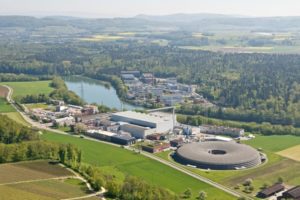The large synchrotron at the Paul Scherrer Institute enables live imaging of pine needle transport highways.
The large synchrotron at the Paul Scherrer Institute has a bit more proverbial firepower than our machines at DTU. From DTU, we sent Francesca Siracusa and Peter Bork to Switzerland in September to help colleagues Chen Gao and Alexander Schultz (University of Copenhagen) with the first of two rounds of scanning live pine needles.
For living biological samples such as pine needles, that enables imaging the spread of tracers as part of normal vascular activity. The flow of water in pine needles and cell volumes can both change over few minutes with light, water and other resources. To probe the effect of changing CO2-concentrations for example, the fast imaging available with the 2.4 GeV photon beams at the Swiss Light Source is a game-changer.
This March, the team of four returns to the Swiss Light Source to take the final images we can get with that equipment for a few years. Due to refurbishment, the facility closes later in 2023. From the acquisition of the images, several steps of software-based reconstructions are crucial steps in generating high quality images. Fortunately we have the expertise at the DTU imaging center to continue with reconstructions, as well as the analyses and quantifications that essentially make up the answers to our research questions.


